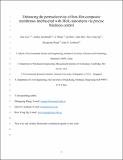| dc.contributor.author | Cao, Siyu | |
| dc.contributor.author | Deshmukh, Akshay | |
| dc.contributor.author | Wang, Li | |
| dc.contributor.author | Han, Qi | |
| dc.contributor.author | Shu, Yufei | |
| dc.contributor.author | Ng, How Yong | |
| dc.contributor.author | Wang, Zhongying | |
| dc.contributor.author | Lienhard, John H | |
| dc.date.accessioned | 2024-03-20T20:33:19Z | |
| dc.date.available | 2024-03-20T20:33:19Z | |
| dc.date.issued | 2022-05-18 | |
| dc.identifier.issn | 0013-936X | |
| dc.identifier.issn | 1520-5851 | |
| dc.identifier.uri | https://hdl.handle.net/1721.1/153824 | |
| dc.description.abstract | The demand for highly permeable and selective thin-film composite (TFC) nanofiltration membranes, which are essential for seawater and brackish water softening and resource recovery, is growing rapidly. However, improving and tuning membrane permeability and selectivity simultaneously remains highly challenging owing to the lack of thickness control in polyamide films. In this study, we fabricated high-performance interlayered TFC membrane through classical interfacial polymerization on a MoS2-coated polyethersulfone substrate. Due to the enhanced confinement effect on the interface degassing and the improved adsorption of the amine monomer by the MoS2 interlayer, the MoS2-interlayered TFC membrane exhibited enhanced roughness and crosslinking. Compared to the control TFC membrane, MoS2-interlayered TFC membranes have a thinner polyamide layer, with thickness ranging from to 85 nm, that can be tuned by altering the MoS2 interlayer thickness. A multilayer permeation model was developed to delineate and analyze the transport resistance and permeability of the MoS2-interlayer and polyamide film through the regression of experimental data. The optimized MoS2-interlayered TFC membrane (0.3-inter) had a 96.8% Na2SO4 rejection combined with an excellent permeability of 15.9 L m-2 38 h-1 bar-1 39 (LMH/bar), approximately 2.4 times that of the control membrane (6.6 LMH/bar). This research provides feasible strategy for rational design of tunable, high-performance NF membranes for environmental applications. | en_US |
| dc.description.sponsorship | Stabngle Support Plan Program of Shenzhen Natural Science Fund (Grant No. 20200925155303001), SUSTech-MIT Joint Center for Mechanical Engineeri Education and Research, and State Environmental Protection Key Laboratory of Integrated Surface Water-Groundwater Pollution Control (China) | en_US |
| dc.publisher | American Chemical Society (ACS) | en_US |
| dc.relation.isversionof | 10.1021/acs.est.2c00551 | en_US |
| dc.rights | Creative Commons Attribution-Noncommercial-ShareAlike | en_US |
| dc.rights.uri | http://creativecommons.org/licenses/by-nc-sa/4.0/ | en_US |
| dc.source | Author | en_US |
| dc.subject | Environmental Chemistry | en_US |
| dc.subject | General Chemistry | en_US |
| dc.title | Enhancing the Permselectivity of Thin-Film Composite Membranes Interlayered with MoS<sub>2</sub> Nanosheets via Precise Thickness Control | en_US |
| dc.type | Article | en_US |
| dc.identifier.citation | Cao, Siyu, Deshmukh, Akshay, Wang, Li, Han, Qi, Shu, Yufei et al. 2022. "Enhancing the Permselectivity of Thin-Film Composite Membranes Interlayered with MoS<sub>2</sub> Nanosheets via Precise Thickness Control." Environmental Science & Technology, 56 (12). | |
| dc.contributor.department | Massachusetts Institute of Technology. Department of Mechanical Engineering | |
| dc.relation.journal | Environmental Science & Technology | en_US |
| dc.eprint.version | Author's final manuscript | en_US |
| dc.type.uri | http://purl.org/eprint/type/JournalArticle | en_US |
| eprint.status | http://purl.org/eprint/status/PeerReviewed | en_US |
| dc.identifier.doi | 10.1021/acs.est.2c00551 | |
| dspace.date.submission | 2024-03-20T16:45:11Z | |
| mit.journal.volume | 56 | en_US |
| mit.journal.issue | 12 | en_US |
| mit.license | OPEN_ACCESS_POLICY | |
| mit.metadata.status | Authority Work and Publication Information Needed | en_US |

